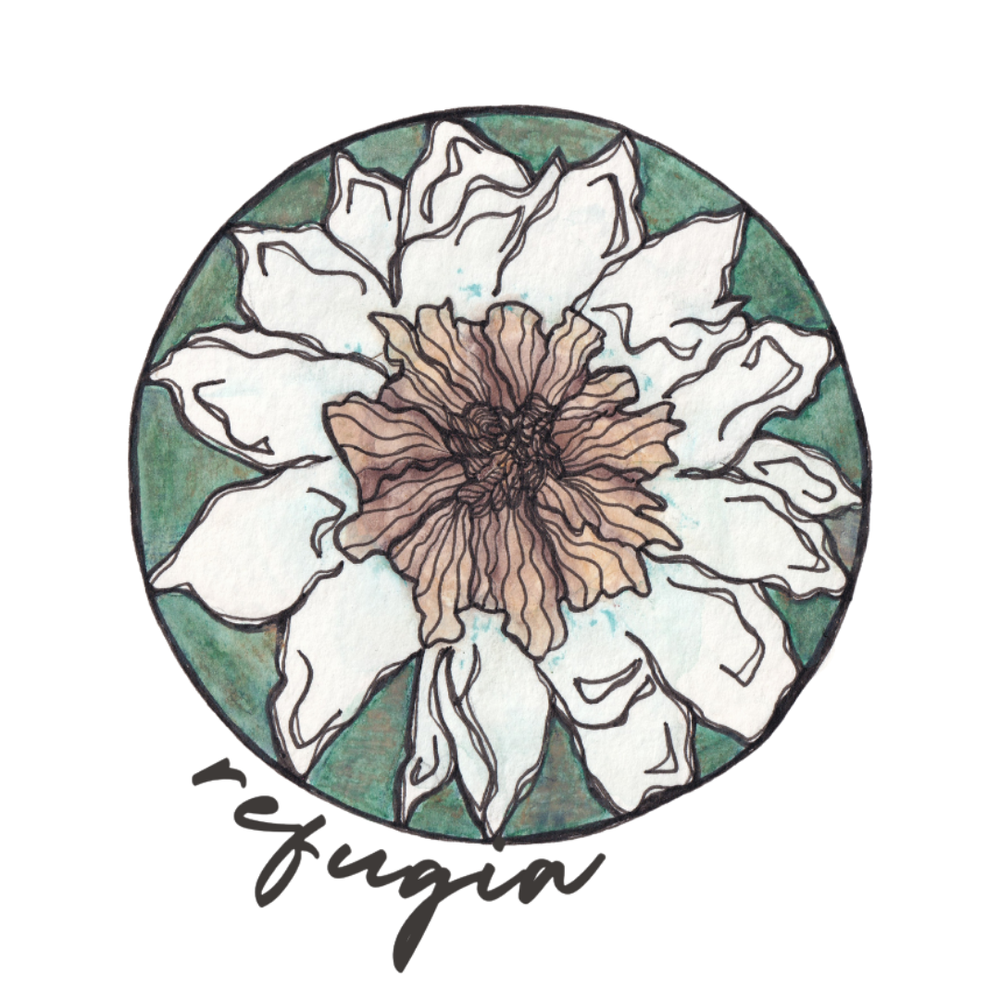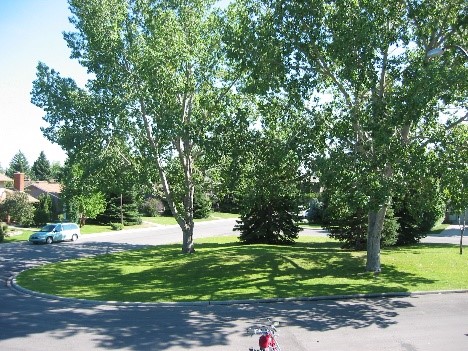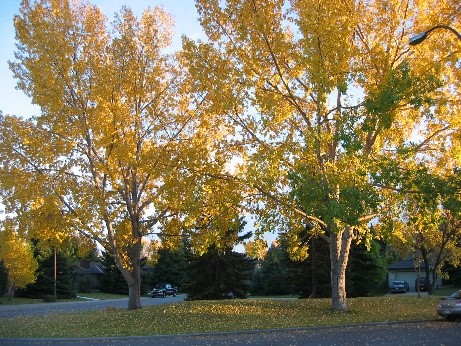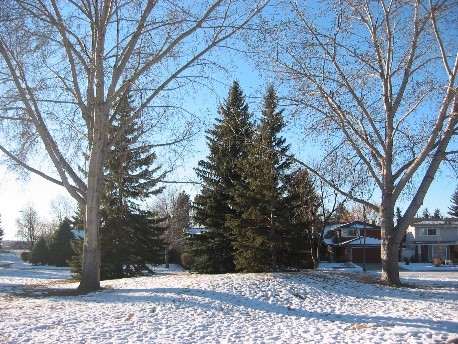By Amy Spark
The trees outside my window as a child shaped my view of the world (both literally and figuratively). I could observe the seasonal changes from my bedroom window. These trees brought me joy, adventure, and comfort. My friends and I would need a ladder just to climb up to the bottom branch, where we would scramble to the heavens. In fall, we would write notes on leaves and roll them into a scroll, tying them closed with the stem, and deposit them into our neighbours’ mailboxes. In winter, the sounds of road hockey would reverberate off their trunks.
One day someone mentioned offhand that “the City” may have to come and chop them down someday, as they were growing too large. From that day, I had a deep-rooted anxiety that my beloved trees would be there one day, gone the next.
Part of the reason Jodi and I started Refugia Retreats was to explore these connections between the self, our natural world, and our communities. How can our communities grow stronger and our connections deeper, as the world changes? We think part of it starts with acknowledging the deep-rooted connections to landscapes and places we all share (and yet experience differently).
Subtle or drastic changes in the environment and ecology around us can have drastic effects on our emotional wellbeing. This applies to natural environments such as parks, green spaces, or individual organisms (for which I use the term ‘ecological grief’) and human-constructed environments such as neighbourhoods, coffee shops, museums, etc. (‘environmental grief’).
Sarah Jaquette Ray, a Professor of Environmental Studies at Humboldt State University, describes environmental programs as “some kind of twelve-step program, with its own arc of affects, moving in stages from idealism, to lost innocence, shame, denial, grief, apathy, optimism, and then, I can only hope, agency to work against diminution.”[1] When one is passionate about a certain place, species, community, friend, or family – it is natural to have anxiety about their decline, and grief for its loss.
In 2016, I had the opportunity to work with citizens of the Ghost River Valley, to explore and record their emotional responses to the changes in landscape around them. Lasting effects from the 2013 flood were apparent, clearcut logging was ongoing, and garbage was piling up beside roadways. What follows is a summary of my research: the similarities and differences between ecological grief and other forms of grief. These observations were made within a system (a case study), but I hope they are helpful if you are experiencing grief or anxiety yourself.
Is ecological grief real? Can you really mourn a landscape?
In short, yes. Responses to landscape alteration look surprisingly like patterns of grief identified by psychologists. Let’s break it down:
1. Everyone’s experience is unique
No two people experience a loss in the same way, and the same person may experience two losses drastically differently. This was true in the Valley – some people moved through the classic “5 stages of loss” identified by Dr. Elisabeth Kübler-Ross. More often however, grief was sporadic: sometimes visceral, sometimes manageable, sometimes anger, sometimes contentment and acceptance.
2. There are physical and physiological responses to loss
Loss of sleep, depression, crying, loss of breath, nausea, inattention or distraction, and aches in the heart or stomach are all physical reactions to loss. All of these were present in at least some of the people affected by the landscape changes.
3. Rites of passage, lamentation, and bereavement groups can help
Several ceremonies were held in the Ghost River Valley to help cope with this loss (see our May 2017 blog post as an example). Participants mentioned talking about their experiences in community often helped them cope. Other forms of lament included art (writing, photography, etc.) and ritualizing loss (ex: cairn of mourning).
4. There’s a strong presence of blame or guilt
Rational or irrational guilt or blame is common during grief. Anger at the person who died, anger at doctors, anger at oneself for not doing more before a person died. As you can imagine, in a system with multiple actors (industry, government, citizens, etc.) blame and guilt can fester. The guilt or blame doesn’t even need to be targeted – it can be obscure or diffuse. One participant put it as “What’s wrong with us? … Where does it come from, this hubristic disregard for the sanctity of the natural world?”.
In environmental change, we’re all to blame, and yet none of us individually are to blame. Environmental degradation is most often a result of a thousand small decisions, rather than few large decisions. So to look for a easy target of blame is understandable, but difficult.
5. These experiences can cause shifts in worldview
Any large life event can shift one’s perception of the world. Environmental change is no different. For some, it creates cynicism. Sarah Jaquette Ray’s students, for example, move from idealism to denial to hope or despair. One Valley resident summarized their change as “all of a sudden I’m like struggling with these big questions… My personality changed… I have shifted from a cold person that only deals in facts to somebody… very different.”
6. Current losses can bring forth losses from the past
Perhaps the most confusing and surprising part of grief is it can muddle our timelines. The loss of someone dear to us can bring forth losses that happened decades ago. That’s because no one exists in a vacuum – people and places influence others – often in ways we don’t truly understand until they’re gone. Memory and place are intricately connected. When a landscape changes, the relationship with others may change too. Perhaps you used to go for walks in a park near your house with a friend. If that park changes, will the relationship with your friend change too? On the other hand, current losses can actually help people grieve previous losses. Connecting with her local community around clearcut logging helped one participant grieve the loss of her father a few years before.
7. Often, these experiences inspire action and a sense of hope
Dr. Kübler-Ross initially developed the 5-stage loss framework when working with people with terminal illness. What she recorded (and later applied more broadly to other forms of loss) was a framework of people grappling with their own death. What is interesting is even despite a terminal prognosis, each and every patient that Kübler-Ross encountered held onto some notion of hope[2]. Environmental degradation inspires similar sentiments of complex hope: nature will rebound, and we will learn from our mistakes and do better. For we only grieve what we love, and we work to protect what we love.
Is ecological grief the same as other forms of grief?
Absolutely not. As mentioned above, all forms of grief are unique. Ecological grief is particularly enigmatic for a few reasons:
1. Dull vs. sharp grief
Unlike the death of a person or clearcut logging event, the degradation of a landscape is often cumulative: increased litter, more disjointed spaces, less birds each year, etc. What I refer to as ‘dull’ grief are the day-in, day-out experiences, aggravations, and worries that come from living in an ecologically unstable world. ‘Sharp’ grief may occur after a specific event: a development, a flood, or a smoke-filled summer. It’s possible for ‘dull’ grief to wear you down, and ‘sharp’ grief to inspire you to action, or vice versa.
2. Simultaneous grief with anticipatory grief
When I lost my nana several years ago, I didn’t grieve her. And there was a lot of guilt around that (see point 4, above). When I discovered the term ‘anticipatory grief’, I understood why. My nana was diagnosed with Alzheimer’s disease, and had a slow decline. Over the years, she lost her bright personality and became confused, frustrated, and short-tempered – all the things she wasn’t. The reason her physical death left me more empty than sad was I had grieved her five years previously. You can grieve someone before they are physically gone.
A landscape is similar. You can grieve a landscape before it is gone – in the same way I had grieved the potential loss of my childhood trees. What makes ecological grief unique, is that you can grieve an environment in an anticipatory manner, while simultaneously be grieving what has already disappeared. Again, timelines get muddled.
3. Shades of loss
In Thom van Dooren’s book Flight Ways[3], he explores the question of species loss: when is a species fully extinct? Is it when the last member of a community has died? Or is it when there are so few numbers of a species are left that their patterns of life have changed? Can you really be a migratory bird when you don’t have friends to migrate with?
An ecosystem doesn’t disappear overnight. By definition, an ecosystem is a system of actors – both living and non-living, human and non-human. When elements are lost in an ecosystem, the system itself is not “dead” or “alive”. It might be less alive or diverse than before, or the elements many shift and change. In one way, this can make it easier to cope with: “well, this part of the forest is gone, but I still have forest over there.” In other ways, it feels like accumulated loss. It can feel like you don’t have a reason or justification to mourn because in some ways it still feels complete. This is an element I would love to explore more in future research.
4. Natural spaces still provide solace throughout a loss
Related to the previous point, what makes ecological grief so complex is that the natural world still provides solace, even as we grieve it. Grief researchers explain that grief may arise from “the withdrawal of psychobiological regulation previously provided by the deceased”[4]. The paradox is the very person who used to be there to help through hard times is not there to help you through the hardest thing at all – their own loss.
Fortunately, natural spaces don’t abandon us fully in the same way. Yes, certain natural spaces change and are lost over time. But thankfully, there are still beautiful spaces out there. Places to walk, think, dream, and play. These remaining spaces can renew and heal us.
And that is what Refugia is all about – finding the spaces of refuge and hope in a changeable world. Fostering healthy communities – both social and ecological. I believe our communities and our compassion are the tools for grappling with these emotional experiences to loss.
If you would like to learn more about this research, please contact us at info@refugiaretreats.com
Join us for part 2 of this blog series next week, Oct 10th, as Jodi shares her story of ecological grief.
[1] Jaquette Ray, S. (2018) Coming of Age at the End of the World: The Affective Arc of Undergraduate Environmental Studies Curricula. In Bladow, K., and Ladino, J. (eds.) Affective Ecocriticism: Emotion, Embodiment, Environment. University of Nebraska Press.
[2] Kübler-Ross, E. (1970) On Death and Dying. London: Tavistock Publications Limited.
[3] van Dooren, T. (2014) Flight Ways: Life and Loss at the Edge of Extinction. New York: Columbia University Press.
[4] LeBlanc, N.J., Unger, L.D., and McNally, R.J. (2016) Emotional and physiological reactivity in Complicated Grief. Journal of Affective Disorders 194: p.98-104.



